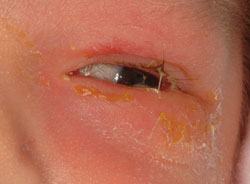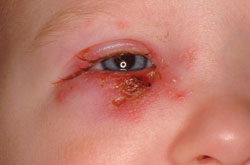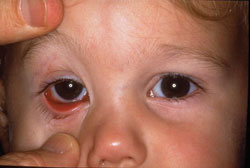A 5-day-old female presents with mild swelling, redness in left eye
Click Here to Manage Email Alerts
A 5-day-old female is seen in the ED for evaluation of a red left eye. The history of the chief complaint began only 6 hours earlier when the parents noted a yellowish discharge from the left eye, along with mild lid swelling and erythema a bit beyond the birthmark she had. There was no fever or change in her activity or appetite, and no other symptoms, such as vomiting, diarrhea, cough, congestion rash or irritability.

The neonate’s past medical history included a normal pregnancy with good prenatal care, labor and delivery, and the mother has no history of sexually transmitted infections. She received her first hepatitis B immunization prior to discharge from couplet care. Her family history is fairly unremarkable; living with her extended family, including several other children, but no known sick contacts. Animal exposure includes only family dogs. She has not left home since birth.
 |
|
Figure 1: There was some dried, yellowish
material between the medial canthus and the bridge of the nose.
|
Examination revealed normal vital signs and a generally normal-appearing baby with a normal exam, with the exception of her left eye. Examination of her eyes included a normal-appearing right eye, but there was some dried, yellowish material between the medial canthus and the bridge of the nose, with a thin amount over the bridge of the nose toward the left eye, as shown in Figure 1. The left eye had mild conjunctival erythema and injection (Figure 2), along with mild swelling and erythema of the lids and some mucopurulent discharge, as seen in Figure 3.
 |
|
Figure 2: The left eye had mild conjunctival
erythema and injection.
|
 |
|
Figure 3: Along with mild swelling and
erythema of the lids, there is some mucopurulent discharge.
|
In the ED, the neonate had a normal complete blood count, and blood culture is pending. She also had the following lab tests: bacterial cultures; Gram stain, Chlamydia polymerase chain reaction (PCR); gonococcal PCR, herpes PCR; adenovirus PCR; and a nasal respiratory virus panel by PCR are pending. The patient was given a dose of cefotaxime IV and oral azithromycin before sending to the ward. HINT: All PCRs and Gram stain were negative.
What’s Your Diagnosis?
A. Chlamydial ophthalmia
B. Haemophilus influenzae (nontypable)
C. Herpes conjunctivitis
D. Adenovirus conjunctivitis
Your choice may not be listed, but of these choices, (B) nontypable Haemophilus influenzae (NTHi) is the most likely and, in fact, that is what grew from the bacterial culture. As mentioned in the hint, all the rapid tests by PCRs were negative, and although these can be falsely negative, there are additional hints against the other choices.
Chlamydial conjunctivitis can occur in a child this young, but typically is seen a bit later; usually 1 to 2 weeks of age. The other key STI that causes neonatal conjunctivitis is Neisseria gonorrhoeae. It tends to occur very early; usually within a couple of days of exposure (birth). Both are more likely to produce a more severe disease, especially N. gonorrhoeae, but there’s obviously some overlap.
Additionally, with good prenatal care, these causes are statistically less likely. The same holds true for herpes simplex virus (HSV), but of course, half of those babies with neonatal herpes infection have mothers with no history of genital herpes; the age of presentation for neonatal HSV is about 5 to 14 days, as in the patient presented. However, a properly obtained specimen should reveal a positive PCR. Also, there may be some cutaneous lesions nearby (Figure 4).
 |
|
Figure 4: There may be some cutaneous
lesions nearby (Figure 4).
|
 |
|
Figure 5: Adenovirus is one of the most
common causes of conjunctivitis in older infants and children.
|
Adenovirus is one of the most common causes of conjunctivitis in older infants and children (Figure 5), but is statistically rare in neonates. It’s not that they cannot get it, they just don’t have as much exposure at this age, and the PCR was negative.
Additionally, other common respiratory viruses are also very uncommon in neonates, but not unheard of. Sometimes, patients can have multiple pathogens simultaneously, as shown in Figure 6, which is an infant with laboratory-verified respiratory syncytial virus rhinitis/bronchiolitis and adenovirus conjunctivitis.
As a general rule, if the baby has an inflamed eye within hours of birth, it is almost always due to chemical irritation from the prophylaxis used. An exception might be if the mother’s membranes had been ruptured for several days. Then all the early-onset causes must be considered.
 |
|
Figure 6: Patients can have multiple
pathogens simultaneously.
|
Back to the answer; NTHi is increasingly recognized as a significant pathogen in neonates, causing everything from early-onset sepsis to conjunctivitis. Colonization is acquired during birth from maternal vaginal flora. Its role in acute otitis media has been long recognized. Further characterization of the role of NTHi as a respiratory tract pathogen is detailed by Schumacher and colleagues in the February issue of the Pediatric Infectious Disease Journal.
Whatever the cause turns out to be, one should work quickly to rule out the more severe possibilities, such as herpes, gonorrhea, chlamydia, Staphylococcus aureus, Pseudomonas aeruginosa, etc, with a good history and physical and any supporting lab tests as needed.
Treatment of neonatal conjunctivitis may need to be fairly aggressive initially until the etiology is known. Then, if it is a common bacterial conjunctivitis, as in this case, one can use sensitivity data from the culture to guide therapy. This patient had a beta-lactamase–negative strain of NTHi that could be treated with several options, both topical and oral.
To read more about conjunctivitis in the pediatric patient, I would refer you to the supplement in the November 2011 issue of Infectious Diseases in Children, “Pediatric Conjunctivitis, current perspectives on treatment to optimize patient care.”
Columnist Comments
This month marks the end of 23 years of writing this column. If you have suggestions or constructive criticisms, please let me know. I have made changes along the way based on your feedback, but we can always make it better. Just let me know at jhbrien@aol.com. Also, I hope your spring is off to a good start.
James H. Brien, DO, is a member of the Infectious Diseases in Children Editorial Board as well as Vice Chair for Education at The Children’s Hospital at Scott and White and is the Associate Professor of Pediatrics at Texas A&M University, College of Medicine, Temple, Texas. email: jhbrien@aol.com. Disclosure: Dr. Brien reports no relevant financial disclosures.
